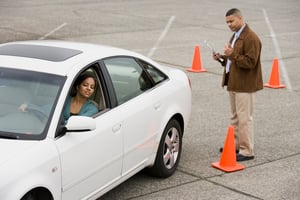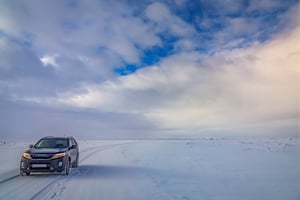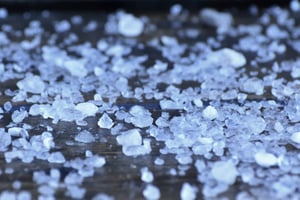 If winter 2019 was your first winter with a teen driver, you’re probably relieved spring is here. Hopefully no more ice, sleet, snow, or whiteout conditions.
If winter 2019 was your first winter with a teen driver, you’re probably relieved spring is here. Hopefully no more ice, sleet, snow, or whiteout conditions.
However, no matter what the season, it can be tricky for young drivers. Springtime driving challenges can include:
- Potholes;
- Deteriorated windshield wipers;
- Hydroplaning; and
- Orange constructions barrels.
Here are some things to watch for and to discuss with your teen driver(s).
Potholes
Potholes can cause significant damage to your car if your teen driver hits them straight on. This can include damage to your tires, rims, suspension, exhaust system, and steering.
All drivers should be leery of what’s hiding under a puddle of water. Always try to steer around a large puddle if you can safely do so. Never swerve as this could put you in the path of an oncoming car.
Windshield Wipers
Windshield wipers are a critical component, but they’re often neglected. They take a beating from the sun, cold, snow, and rain. Make sure you change the windshield wipers on your cars every six months. Doing this ensures the best vision possible.
Hydroplaning
During rainy conditions, hydroplaning can occur. Hydroplaning is a function of speed, inadequate tire tread, and standing water. Hydroplaning occurs when water on the road causes your tires to lose contact with the road. This loss of contact results in a loss of steering and braking.
Check your car’s tires to make sure they have adequate tread to push the water away from the tire. Also, never use cruise control on a wet surface.
Road Construction
In Wisconsin, orange road construction barrels have started making their way onto our freeway system. It’s important to obey reduced speed limit signs to keep the construction workers safe. In addition, it’s important to watch for changing traffic patterns.
Road America’s Teen Driving School
To improve your teen drivers’ skills and help learn how to safely navigate around springtime challenges, consider enrolling them in Road America’s Teen Driving School sponsored by West Bend. Road America’s Teen Driving School is an advanced driving school that focuses on skills not taught in driver’s education. Skills include:
- Skid prevention and control – Teaches how to react and handle a car if you lose control.
- ABS vs. threshold braking – Teaches the difference between the two and how to effectively use ABS brakes. Never pump ABS brakes!
- Collision avoidance maneuvers – Teaches how to make aggressive lane changes while keeping your car in control.
- Proper vision skills – Teaches where to look, proper mirror use, and viewing traffic situations from a distance.
This program is offered several times during the year at Road America in Elkhart Lake, WI and runs from 9:00am to 4:00pm CST.
2019 Dates
- Saturday, April 13
- Saturday, May 4
- Sunday, August 18
- Saturday, October 26
- Sunday, October 27
- Saturday, November 2
- Sunday, November 3
If you don’t live in the area, consider finding an advanced driving school near you or visit Road America in Elkhart Lake, Wisconsin. I’m sure you’ll enjoy it.
Topics: Auto Safety, Teen Safety
SOURCE: West Bend, Scott Stueber on Mar 26, 2019 9:33:31 AM
 Power strips and surge protectors are a necessity in many homes today. With smartphones, tablets, streaming media devices, and gaming consoles, we have a lot of toys to plug in. Don’t forget about TVs, lamps, and other household items. All these items plugged into a power strip can put stress on it.
Power strips and surge protectors are a necessity in many homes today. With smartphones, tablets, streaming media devices, and gaming consoles, we have a lot of toys to plug in. Don’t forget about TVs, lamps, and other household items. All these items plugged into a power strip can put stress on it. Buying a new vehicle can be very exciting. I remember purchasing my first brand new vehicle. Ahh, that new car smell.
Buying a new vehicle can be very exciting. I remember purchasing my first brand new vehicle. Ahh, that new car smell. Just when you think you’ve seen your last snowfall or cold spell, Mother Nature plays another trick on you. Winter weather can make it difficult for our cars to run efficiently or even run at all.
Just when you think you’ve seen your last snowfall or cold spell, Mother Nature plays another trick on you. Winter weather can make it difficult for our cars to run efficiently or even run at all. With several weeks of winter left, and then the transition to spring, salt could still play a big part in keeping your property safe. Part of being prepared is knowing the specifics of the deicers you’re using on your driveway or sidewalk. Each type of deicer has different melting properties and uses. Consider all factors when choosing the product best for you.
With several weeks of winter left, and then the transition to spring, salt could still play a big part in keeping your property safe. Part of being prepared is knowing the specifics of the deicers you’re using on your driveway or sidewalk. Each type of deicer has different melting properties and uses. Consider all factors when choosing the product best for you.